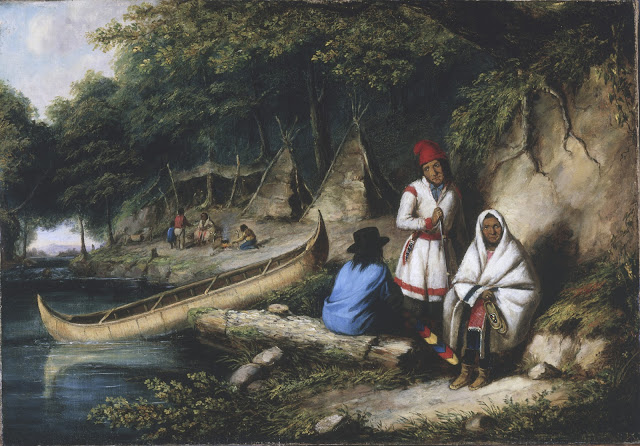The next year in 1848, Krieghoff created another piece based on this image with some minor modifications. The image was retitled, "
Indian Wigwam in Lower Canada" and was used to create a lithograph for publication. Multiple copies of these lithographs were distributed around the world over the years and have often come up for auction. An example is the following image by William Reese Company.
INDIAN WIGWAM IN LOWER CANADA.
Krieghoff, Cornelius:
[Montreal: R. & C. Chalmers, 1848]. Lithograph, 15 x 20 inches (visible portion).
Item #WRCAM32676
In Krieghoff's updated version, the shaft and bobble shaped grip of the paddle are now in view, eliminating the missing distortion in the previous work. Krieghoff also decided to reverse the chevron pattern on the blade so that the decorations are now "pointing" up towards the grip rather than down towards the blade tip. In order to enhance the appearance of greyscale lithographs, many were subsequently coloured by other artists resulting is slightly different renditions of the paddle decoration.
The McCord Museum also has one of these painted lithograph prints. The coloured bands on the blade and shaft follow a Red - Yellow - Blue sequence from the tip upwards.
Indian Wigwam in Lower Canada
Cornelius Krieghoff (1815-1872)
About 1850, 19th century
Another version now in the National Gallery of Canada (uploaded to Wiki Commons) is a more brightly coloured version with the same decoration pattern.
Indian Wigwam in Lower Canada
Cornelius Krieghoff
Lithograph with watercolour on wove paper
National Gallery of Canada
Credit line: Gift of Donald Maclaren, Ottawa, 1990
Accession number: 30820
The Toronto Public Library Special Collections Archive also contains a version. This one has a more significant pattern change. The chevron pattern is Yellow - Red - Blue - Red - Yellow - Blue and the banded decoration on the shaft has been replaced with an all red.
Indian Wigwam in Lower Canada (1848)
Creator: Cornelius Krieghoff, 1815-1872
Contributors:Thomas Kammerer; Andreas Borum, 1799-1853
Identifier: 022kieghoff-inidan-wigwam
Format: Picture
Rights: Public domain
Gift of the Bain family - 2008.
Courtesy: Toronto Public Library
Canadian Auction House Waddington's had a print for sale back in 2016. This one has the Red - Yellow - Blue banded pattern on the shaft culminating in a red bobble grip. The blade has a curious pattern of Red - Yellow - Blue then a plain or natural looking band again followed by a Yellow - Blue - Red.
Lot 59:
Indian Wigwam in Lower Canada (1848)
Waddington's
November 21, 2016
Toronto, ON, CA
The version on Artnet Auctions has a Yellow - Red - Blue pattern on the blade. The shaft however is decorated with the alternating pattern of thick yellow bands followed by thin red lines.
Indian Wigwam in Lower Canada (1848)
Artnet Auctions
A final version is in the collection of the Library and Archives of Canada. This one has a blade pattern of Yellow - Red - Blue repeating up the shaft.
Indian Wigwam in Lower Canada (1848)
Credit: Library and Archives Canada, Acc. No. 1989-511-1
Copyright: Expired
MIKAN 2836651
March 2018 Update: My reproduction of this paddle has been completed. See
HERE for that post.






















































